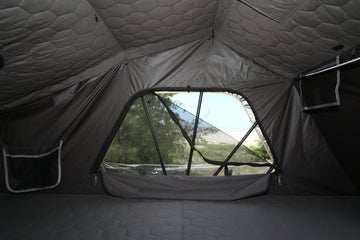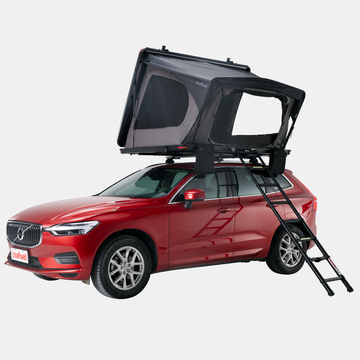
In the previous episode, we discussed the origins and evolution of rooftop tents, gaining an understanding of their history, development, classifications, and their respective advantages and disadvantages. I believe you now have a basic understanding of rooftop tents.
Now, when you are preparing for your camping journey, do you know how to choose the rooftop tent that is most suitable for you? When purchasing your first rooftop tent, I believe you also searched various brand websites to learn about the types of tents and some basic information. You explored people's evaluations and feedback on platforms like social media, YouTube, Instagram, Facebook, and others. During this process, you may have encountered problems such as inaccurate information on websites, resulting in receiving a product that doesn't match the description. Perhaps there was a question that you were concerned about but others didn't mention, leaving you unsatisfied with the tent you finally chose. Spending too much time during the selection process and not having comprehensive enough information are also potential issues that might prevent you from finding your favorite tent. After finally choosing a tent style you like, you may start hesitating about the details of the tent. What size and weight should you choose? Should the mattress be thinner or thicker?
Therefore, in this video, we will take the perspective of first-time campers and tell you how to choose the rooftop tent that suits you best.
First, let's talk about structure and opening mechanisms. In the previous episode, we mentioned the five most common structures: straight-on type, triangle type, clam shape type, Z shape type, and hybrid type. They can generally be classified into three opening mechanisms:
Pop-Up: This opening mechanism is usually simple and quick. The tent's top is equipped with a spring mechanism, utilizing a straightforward mechanical system. By unlocking or releasing the fastening, the tent can pop up and unfold, taking only about 30 seconds to open. Compared to other types of tents, it is more budget-friendly. This type is generally suitable for campers who want to save time or have a limited budget. Straight-on type tents usually rely on springs to support the tent structure, which may result in lower stability and strength. In strong winds or adverse weather conditions, straight-on type tents may be less stable compared to other tents.
Hydraulic: This opening mechanism uses hydraulic bars to support and set up the tent. The tent has hydraulic devices on both sides, usually requiring only a gentle push to open it. Combined with some pole setups, the tent can generally be set up within a minute. Hydraulic bars provide good stability and strength, enabling the tent to withstand strong winds, vibrations, and other external forces during harsh weather. This opening mechanism is commonly used in hardtop tents, making them relatively more expensive and heavier than regular tents.
Folding: This type of tent is usually composed of multiple foldable panels that can be unfolded and folded up like a folding ladder. When closed, the overall structure is compact, but when opened, it provides a spacious sleeping area. Folding tents have a more complicated opening mechanism and require more effort, as well as some additional operating steps.
Secondly, let's discuss size. The size of the tent's space is also limited by its dimensions and the number of people it can accommodate. Therefore, before purchasing a tent, you need to determine the size you require and how many people you want to accommodate.
The length of tents is mostly around 79 inches, and the width of two-person tents generally ranges from 49 to 55 inches, while three to four-person tents typically have a width of 72 to 80 inches.
Different styles of tents offer different feelings when opened. If you want a larger space, you can choose the hybrid type. This style becomes much more spacious when opened compared to when closed because it hides a lot of space when folded.
The clam shape type is also a good choice as it usually provides generous internal space.
If you are tall and desire more headroom, the straight-on type and Z shape type will be your first choices. They open up into a box-like shape and have greater height, allowing you to sit inside the tent for conversations and entertainment. The triangle type, on the other hand, has the smallest space. When opened, it forms a triangle shape, reducing the internal space by half compared to the straight-on type and Z shape type.
If you sleep on the lower side, you may feel somewhat constrained, and if you sleep on the higher side and raise your feet slightly, the space will also be limited.
Third, Weight: The weight of a rooftop tent can vary depending on the brand, model, and size. The weight of the rooftop tent may affect the vehicle's load capacity and driving performance. To ensure safety and proper usage, it is recommended to consult the vehicle manufacturer's information regarding load capacity, roof structure limitations, and the weight of the tent before purchasing.
Soft-shell tents are generally made of canvas or nylon, known for their lightweight nature, but they may not be as durable as other tent styles. On top of that, hybrid types that combine soft and hard shells significantly enhance durability but also add to the weight.
The heaviest option is the aluminum shell tent, which typically has a sturdy aluminum alloy shell to increase its strength and durability. If you plan to use the rooftop tent long-term or camp in various environmental conditions, an aluminum shell rooftop tent may be a reliable choice. However, if you have higher weight requirements or wish to install the tent on a smaller vehicle, you can consider other lightweight materials such as soft-shell tents or hybrid types.






